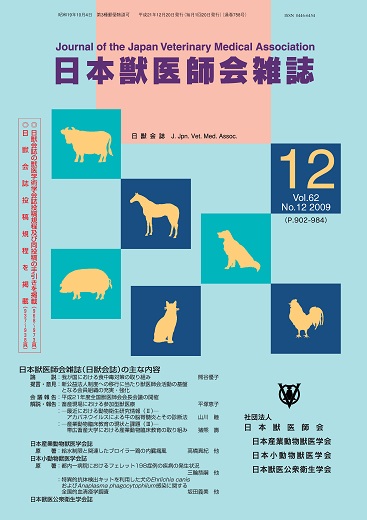All issues

Volume 62, Issue 12
Displaying 1-5 of 5 articles from this issue
- |<
- <
- 1
- >
- >|
The Japanese Society of Farm Animal Veterinary Medicine
-
Maki TAKAHASHI, Yukio SEIMIYA, Chihiro SATO, Ieharu SASAKI, Yoshihiro ...Article type: Original Article
2009 Volume 62 Issue 12 Pages 941-945
Published: December 20, 2009
Released on J-STAGE: September 03, 2016
JOURNAL FREE ACCESSAfter a flock of 7,100 broiler chickens had been exposed to severe water restrictions from 18 to 23 days of age, 1,481 birds (21%) developed anorexia and depression followed by death between 21 and 26 days of age. Mortality reached its peak on the fifth and sixth day following the restriction, and decreased abruptly after adequate volumes of water were provided. A total of 29 affected chickens were examined at 23 days of age. The serum uric acid values in 21 examined birds had increased with the level ranging from 11 to 500 mg/dl, and urates were precipitated in the kidneys of 14 birds pathologically examined. Neither hemagglutinative virus nor infectious bronchitis virus gene was detected from the 14 birds. On the fourth day following resumption of the water supply, the serum uric acid values in 11 examined birds had decreased with the level ranging from 3.2 to 12.5 mg/dl, and no urates were precipitated in any tissues of six birds. Based on the results, all 29 examined chickens at 23 days of age were diagnosed with visceral gout. Dehydration due to water restrictions followed by visceral gout could be responsible for the higher mortality in the flock.View full abstractDownload PDF (497K)
The Japanese Society of Small Animal Veterinary Medicine
-
Yasutsugu MIWA, Seiji HOSAKA, Nobuo SASAKIArticle type: Original Article
2009 Volume 62 Issue 12 Pages 947-951
Published: December 20, 2009
Released on J-STAGE: September 03, 2016
JOURNAL FREE ACCESSThe incidence of ferret diseases at an animal hospital was investigated from November 2006 to April 2008. A total of 261 diseases in 198 ferrets were confirmed during the research period. When classifying them according to the organ systems, higher incidences of endocrine (34.9%), gastrointestinal (17.6%), and dermatological diseases (10.3%) were observed, followed by urologic and hemolymphatic diseases. Comparing the incidence of each disease, adrenal disease (24.5%), insulinoma (10.0%) and diarrhea (6.5%) showed a higher incidence,followed by ear mites and renal disease. In addition, neoplastic diseases seemed to be one of the more common diseases. The age of onset differed, depending on the disease. Endocrine diseases were seen in middle to older age groups, ear mites in younger age groups, and diarrhea in younger and middle age groups, respectively.View full abstractDownload PDF (285K) -
Yoshimi SAKATA, Yasuaki ICHIKAWA, Hisashi INOKUMAArticle type: Original Article
2009 Volume 62 Issue 12 Pages 952-955
Published: December 20, 2009
Released on J-STAGE: September 03, 2016
JOURNAL FREE ACCESSA seroepidemiological survey of Ehrlichia canis and Anaplasma phagocytophilum infection in dogs in Japan was performed by using a combination of a classical immunofluorescence antibody assay (IFA) and a new enzyme immune assay (EIA) kit that uses a specific recombinant major surface protein of the pathogens. Although 64 (5.3%) of 1,206 dogs showed IFA antibodies against E. canis with titers of 20 or more, all 64 were negative for E. canis via the EIA kit. The results of IFA were believed to be false positive, resulting from infection with closely related Ehrlichia species. Three (0.2%) of 1,206 dogs showed IFA antibodies against A. phagocytophilum with titers of 20 or more. One of these three dogs also showed positive for A. phagocytophilum in the EIA kit. It was suggested that the dog might be infected with A. phagocytophilum in Japan.View full abstractDownload PDF (245K) -
Takehiro UNO, Kentarou OKAMOTO, Chiharu ONAKA, Keiichi FUJITA, Hozumi ...Article type: Short Communication
2009 Volume 62 Issue 12 Pages 956-961
Published: December 20, 2009
Released on J-STAGE: September 03, 2016
JOURNAL FREE ACCESSA miniature dachshund, 5 years and 3 months of age, with a history of cholecystitis associated with biliary calculus that had developed one year previously, presented with anorexia and vomiting. A series of examinations, including CT imaging by drip infusion cholangiography (DIC-CT), revealed that no bile was flowing into the gallbladder. Thickening of the gallbladder wall and a biliary calculus occupying the lumen of the gallbladder with a laminated internal structure were also found. Based on the results of a detailed examination,the gallbladder was extracted. E.coli and Enterococcus sp. were isolated by microbiological tests inside the gallbladder and around its outer wall. The findings of drug susceptibility tests indicated that the E. coli could be a substrate-specific, broad spectrum, βhlactamase-producing bacterium. In this case, administration of faropenem sodium was initiated before the surgery and the postoperative course was good. DIC-CT imaging can properly visualize the biliary duct system, and an explanation that relied on these images was useful for the dog's owner. It was thought that surgical treatment should actively be considered to prevent a relapse of cholecystitis in cases involving cholecystitis associated with biliary calculi.View full abstractDownload PDF (481K)
The Japanese Society of Veterinary Public Health
-
Shigemitsu EBIHARA, [in Japanese], [in Japanese], [in Japanese], [in J ...Article type: Data and Information
2009 Volume 62 Issue 12 Pages 963-966
Published: December 20, 2009
Released on J-STAGE: September 03, 2016
JOURNAL FREE ACCESSDownload PDF (471K)
- |<
- <
- 1
- >
- >|